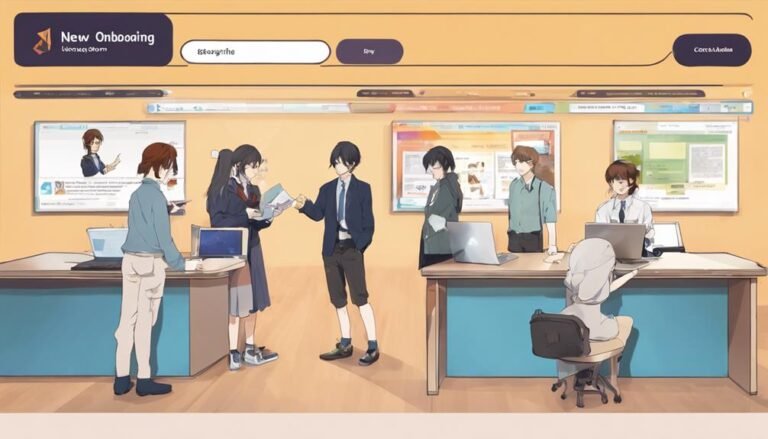What Are the Best Practices for Creating Engaging and Accessible Multimedia
To create engaging and accessible multimedia, prioritize color contrast and font legibility for visual appeal. Use clear, accessible fonts to enhance readability. Incorporate captions and transcripts for inclusive communication and SEO benefits. Audio descriptions enrich accessibility by providing detailed narration for all users. Guarantee keyboard accessibility for efficient navigation and inclusivity. Utilize user testing and feedback to refine your content, making it more engaging and accessible. By implementing these practices, you can enhance the overall user experience and make your multimedia content more inclusive and interactive. Learn how to further improve engagement and accessibility by exploring the key design principles outlined.
Key Takeaways
- Utilize color contrast and legible fonts for visual appeal and readability.
- Include captions and transcripts for inclusive communication and SEO benefits.
- Provide audio descriptions for enhanced accessibility and engagement.
- Ensure keyboard accessibility for efficient navigation and usability.
- Conduct user testing and feedback loops for continuous improvement and enhanced accessibility.
Visual Design Principles
When crafting multimedia content, make sure your visual design principles are thoughtfully integrated to captivate and guide the viewer effectively. Two essential elements to contemplate are color contrast and font legibility. Color contrast plays a significant role in ensuring that your content is visually appealing and accessible to all viewers. By using contrasting colors, you can make important information stand out and improve overall readability.
In addition to color contrast, font legibility is equally important in the design process. Choosing appropriate fonts that are easy to read is crucial for ensuring that all viewers can engage with your content without straining their eyes. Opt for clear, legible fonts that are accessible to individuals with visual impairments.
Captions and Transcripts
To enhance the accessibility and engagement of your multimedia content, incorporating captions and transcripts is crucial. These features not only cater to individuals with hearing impairments but also improve the overall user experience. Here are some key points to take into account when adding captions and transcripts to your multimedia content:
- Inclusive Communication: Captions and transcripts guarantee that your content can be understood by a wider audience, including those who are deaf or hard of hearing.
- Accessibility Features: By providing captions and transcripts, you make your multimedia content accessible to individuals who may have difficulty processing audio information.
- Enhanced Engagement: Captions can help reinforce the message being conveyed in the multimedia content, making it easier for viewers to follow along.
- SEO Benefits: Search engines can index the text from captions and transcripts, improving the discoverability of your multimedia content online.
Audio Descriptions
Consider enhancing the accessibility and inclusivity of your multimedia content by incorporating informative audio descriptions. Audio descriptions provide individuals with visual impairments a detailed narration of visual content, ensuring they can fully engage with your multimedia. By using descriptive language and audio cues, you can paint a vivid picture of scenes, actions, and expressions that may not be discernible through sound alone. This practice promotes inclusion by making your content more accessible to a wider audience.
| Benefits of Audio Descriptions |
|---|
| Enhances accessibility |
| Promotes inclusion |
| Increases engagement |
Implementing audio descriptions not only meets accessibility standards but also enriches the viewing experience for all users. Whether it's describing key visual elements, gestures, or scene changes, incorporating audio descriptions demonstrates a commitment to creating engaging and inclusive multimedia content.
Keyboard Accessibility
Explore how guaranteeing keyboard accessibility enhances user experience and inclusivity in your multimedia content. When designing your multimedia, consider the following to ensure keyboard accessibility:
- Focus management: Properly manage the focus order of interactive elements on your multimedia content. This allows users to navigate through your content using only the keyboard, enhancing usability for those who rely on keyboard navigation.
- Interactive elements: Ensure all interactive elements, such as buttons and links, are keyboard accessible. Users should be able to interact with these elements using the tab key for navigation and the enter key to activate them, providing a seamless experience for keyboard-only users.
- Screen readers: Keyboard accessibility is vital for users who rely on screen readers. By guaranteeing all elements are reachable and operable via the keyboard, you make your multimedia content more inclusive and usable for all audiences.
- Tab navigation: Test the tab navigation flow within your multimedia content to ensure logical and intuitive navigation for keyboard users. Proper tab order helps users move through content efficiently, improving their overall experience.
User Testing and Feedback
Optimize the user experience of your multimedia content by incorporating usability testing and feedback loops to refine its accessibility and engagement.
Usability testing involves observing real users interacting with your multimedia to identify potential usability issues and gather insights on how to improve the overall user experience. By engaging in this process, you can uncover areas where users may struggle to access or engage with your content, allowing you to make necessary adjustments for better accessibility.
Feedback loops are essential for continuously improving your multimedia content based on user input. Encouraging users to provide feedback through surveys, comments, or user testing sessions can offer valuable perspectives on what's working well and what can be enhanced. Analyzing this feedback and implementing relevant changes can lead to a more engaging and accessible multimedia experience for all users.
Conclusion
To sum up, incorporating visual design principles, providing captions and transcripts, including audio descriptions, ensuring keyboard accessibility, and conducting user testing are all essential practices for creating engaging and accessible multimedia content.
By following these best practices, you can create an immersive and inclusive experience for all users. It's like adding a splash of color to a black and white world – it brings your content to life in ways you never imagined.
So go ahead, get creative and make your multimedia content shine!







